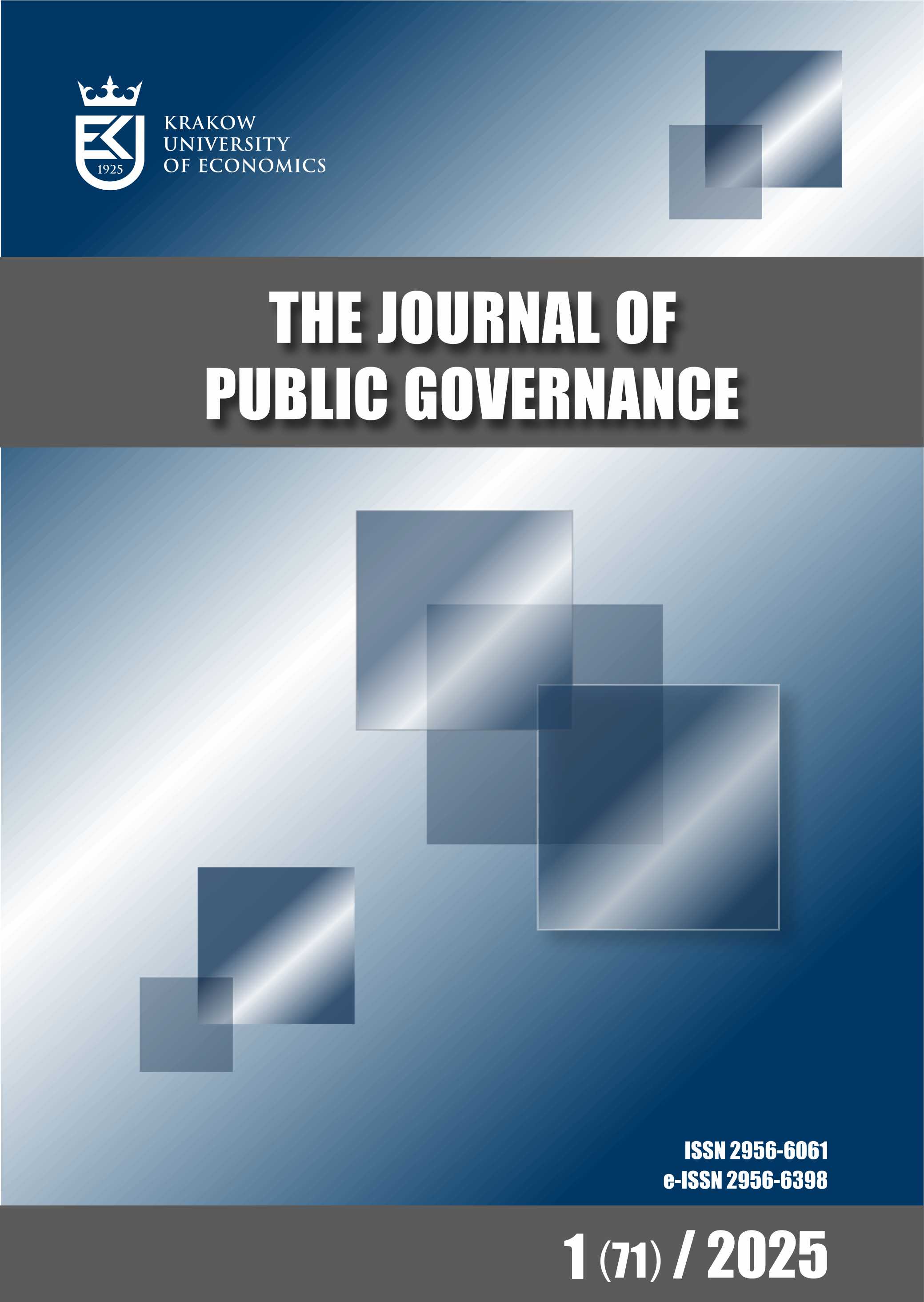Performance Audit Effectiveness Indicators: Evidence from Poland
DOI:
https://doi.org/10.15678/PG.2022.61.3.03Keywords:
performance audit, effectiveness, public administrationAbstract
Objective: Performance audits, conducted by both internal and external auditors in public administration, play a crucial role in assessing effectiveness. This research focuses on the experiences of the Supreme Audit Institution (SAI) in Poland, delving into the effects of performance audits. Previous studies from selected developed countries shed light on performance audit impact, categorised as instrumental, conceptual, interactive, and political-legitimating. However, the generalisability of these findings is constrained by limited research, varying institutional and social contexts, and country-specific factors. To address these gaps, the authors of his study aim to expand knowledge on performance audit effectiveness indicators.
Research Design & Methods: The research combines a literature review, analytical induction through interviews with SAI executives, and analysis of SAI activity reports from 2019–2021.
Findings: The study reveals diverse interpretations of performance audit effectiveness among SAI delegation directors, encompassing process, results, and effects. Additionally, the research identifies indicators relevant to assessing performance auditing effectiveness in the Polish context. It emphasises the need for context-specific evaluations due to differing institutional and social conditions across countries.
Implications/Recommendations: While acknowledging limitations, including the small sample size, this pilot study paves the way for future research to validate its hypotheses, explore factors influencing performance audit effectiveness, and compare practices across countries. Ultimately, it aims to enhance the effectiveness of performance audits in public administration.
Contribution / Value Added: This research contributes to academia and practice by offering comprehensive performance audit effectiveness indicators. It introduces a novel indicator related to reporting infringements in public finance law and discipline.
Downloads
References
Bemelmans-Videc, M.L., Lonsdale, J. & Perrin, B. (2007), Making Accountability Work: Dilemmas for Evaluation and for Audit. Transaction Publishers.
Bryman, A., & Bell, E. (2011). Business Research Methods. Oxford University Press.
Clak, J.M., & Bednarek, P. (2021). Audyt efektywnościowy czy audyt wykonania zadań w jednostkach sektora finansów publicznych – przegląd literatury krajowej i zagranicznej. Prace Naukowe Uniwersytetu Ekonomicznego we Wrocławiu, 65(2), 15–32.
De Waele, L., & Polzer, T. (2021). “A little bit of everything?” Conceptualising performance measurement in hybrid public sector organisations through a literature review. Journal of Public Budgeting, Accounting & Financial Management, 33(3), 343–363. https://doi.org/10.1108/JPBAFM-05-2020-0075
Diefenbach, T. (2009). New Public Management in public sector organizations: The dark side of managerialistic “enlightenment”. Public Administration, 87(4): 892–909. https://doi.org/10.1111/j.1467-9299.2009.01766.x
Etverk, J. (2002). Measuring performance audit effectiveness: The case of Estonia, Master’s Thesis, University of Tartu.
International Organisation of Supreme Audit Institutions [INTOSAI]. (2022). Performance Audit. ISSAI Implementation Handbook. https://www.idi.no/elibrary/professional-sais/issai-implementation-handbooks/handbooks-english/performance-audit-v1-2021/1330-idi-performance-audit-issai-implementationhandbook-v1-en/file
Lehtonen, M. (2005), OECD Environmental Performance Review Programme: Accountability (f)or Learning? Evaluation, 11(2), 169–188.
Lonsdale, J. (2011). Introduction. In J. Lonsdale (Ed.), Performance auditing. Contributing to accountability in democratic government (pp. 1–21). Edward Elgar Publishing Ltd.
Lonsdale, J., & Bechberger, E. (2011). Learning in an accountability setting. In J. Lonsdale (Ed.), Performance auditing. Contributing to accountability in democratic government (pp. 268–288). Edward Elgar Publishing Ltd. https://doi.org/10.4337/9780857931801.00020
Makowski, P. T. (2017). Effectiveness and Efficiency: The Praxiological Sense of Actions. In: Tadeusz Kotarbiński’s Action Theory. Palgrave Macmillan. https://doi.org/10.1007/978-3-319-40051-8_3
Morin, D. (2008), Auditors general’s universe revisited. An exploratory study of the influence they exert on public administration through their value for money audits. Managerial Auditing Journal, 23(7), 697–720.
NIK. (2020). Sprawozdanie z działalności Najwyższej Izby Kontroli w 2019 roku. Departament Strategii Najwyższej Izby Kontroli. https://www.nik.gov.pl/plik/id,22569,vp,25256.pdf
NIK. (2022a). O NIK. https://www.nik.gov.pl/
NIK. (2022b). Sprawozdanie z działalności Najwyższej Izby Kontroli w 2021 roku. Departament Strategii Najwyższej Izby Kontroli. https://www.nik.gov.pl/plik/id,26137.pdf
Nobles, J. R., Brown, J. R., Ferris J. A., & Fountain J. R., Jr. (1993). AGA task force report on performance auditing. The Government Accountants Journal, 42(2), 1–13.
Nutley, S., & Webb, J. (2000). Evidence and the policy process. In H. Davies, S. Nutley, & P. Smith (Eds.), What Works? Evidence-Based Policy and Practice in Public Services (pp. 13–42). The Policy Press. https://doi.org/10.56687/9781847425119
Pollitt, C., Girre, X., Lonsdale, J., Mul, R., Summa, H., & Wearness, M. (1999). Performance or compliance? Performance audit and public management in five countries. Oxford University Press. https://doi.org/10.1093/acprof:oso/9780198296003.001.0001
Reichborn-Kjennerud, K. (2015). Resistance to control – Norwegian ministries’ and agencies’ reactions to performance audit. Public Organization Review, 15, 17–32 https://doi.org/10.1007/s11115-013-0247-6
Sagan, A. (2007). Analiza danych jakościowych w badaniach marketingowych – podstawowe podejścia. Zeszyty Naukowe Akademii Ekonomicznej w Krakowie, 739, 37–51. https://r.uek.krakow.pl/bitstream/123456789/2489/1/150162202.pdf
Stevenson, A. (2010). Oxford Dictionary of English (3rd edition). Oxford University Press. https://doi.org/10.1093/acref/9780199571123.001.0001
Stroińska, E. (2020). New Public Management as a Tool for Changes in Public Administration. Journal of Intercultural Management, 12(4), 1–28. https://doi.org/10.2478/joim-2020-0048
Torres, L., Yetano, A., & Pina, V. (2016). Are performance audits useful? A comparison of EU practices. Administration & Society, 51(3), 431–462. https://doi.org/10.1177/0095399716658500
Van Der Meer, F. B. (1999). Evaluation and the social construction of impacts. Evaluation, 5(4), 387–406. https://doi.org/10.1177/135638999400830048
Van Loocke, E., & Put, V. (2011). The impact of performance audits: A review of the existing evidence. In J. Lonsdale, P. Wilkins, & T. Ling (Eds.), Performance auditing. Contributing to accountability in democratic government (pp. 175–208). Edward Elgar Publishing Ltd. https://doi.org/10.4337/9780857931801.00016
Weihrich, D. (2018). Performance auditing in Germany concerning environmental issues. Sustainability Accounting, Management and Policy Journal, 9(1), 29–42. https://doi.org/10.1108/SAMPJ-04-2017-0036
Weiss, C. (1979). The many meanings of research utilization. Public Administration Review, 39(5), 426–431. https://doi.org/10.2307/3109916
Zieleniewski, J. (1965). Organizacja zespołów ludzkich. Wstęp do teorii organizacji i kierowania. Państwowe Wydawnictwo Naukowe.
Downloads
Published
Issue
Section
License
Copyright (c) 2022 Journal of Public Governance

This work is licensed under a Creative Commons Attribution 4.0 International License.



